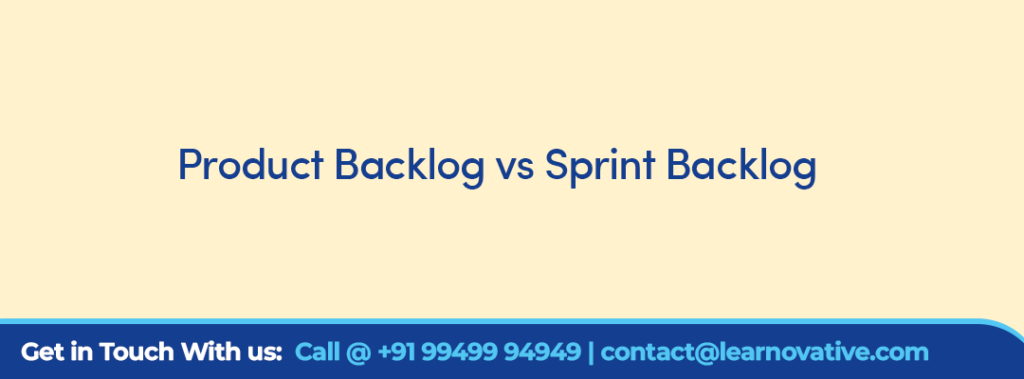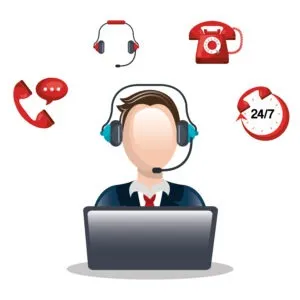
Scrum has 3 Artifacts: Product Backlog, Sprint Backlog and Increment. The primary purpose of these Artifacts is to enhance “Transparency”, the first leg of Empirical Process Control. In this article, you are going to understand the differences between the Product Backlog and Sprint Backlog.
| Difference Factor | Product Backlog | Sprint Backlog |
| Creation | Product Backlog will be created only once for every Product/Project at the beginning and the Product Owner creates the Product Backlog. | Sprint Backlog is created for every Sprint in the Sprint Planning. The Developers will create the Sprint Backlog in collaboration with the Product Owner and Scrum Master in the Sprint Planning. |
| Content | Product Backlog contains the possible “known” items of the Product at any point of time. These items are nothing but anything that is needed to improve the Product. Product Backlog contains the “WHY”, and “WHAT”. The “WHY” is the Product Goal | Sprint Backlog contains only the items that are selected for the current Sprint. It is a subset of the Product Backlog. Sprint Backlog contains “WHY”, “WHAT” and “HOW” Also. The “WHY” is the Sprint Goal |
| Ownership | Product Owner owns the Product Backlog. He/she has complete authority on the content and the order of the Product Backlog. | Developers own the Sprint Backlog. They use it to manage their work during the Sprint. |
| Management | Product Owner is accountable for the Product Backlog Management. Even though he/she can delegate this to others, he/she remains accountable. | Developers collectively are responsible for managing the Sprint Backlog. They are self-managing so they will have to keep the Sprint Backlog up-to-date throughout the Sprint. |
| Changes | Product Backlog can be changed at any point of time based on the need | Sprint Backlog cannot change during the Sprint if the change(s) endanger the Sprint Goal |
| Details of the Items | All items that are in Product Backlog may not be detailed. Only the higher-order items will be more granular and more detailed compared to lower order items. | All the items in the Sprint Backlog will have enough details as they will be implemented in the current Sprint. |
| Sharing | In case there are multiple teams working on the same Product, then all the Scrum Teams will share the same Product Backlog. | Sprint Backlog cannot be shared by multiple Scrum Teams. Each Scrum Team will have their own Sprint Backlog. |
| Refinement | Product Backlog Items will be continuously refined during the PBR activity, the Product Backlog Refinement. | There is no refinement needed for the Sprint Backlog as they were already discussed during earlier Product Backlog Refinement or the current Sprint Planning. If needed, the Developers can discuss the queries with the Product Owner throughout the Sprint for the current Sprint items. So there is no need for a separate refinement. |
| Estimation | All the items in the Product Backlog may not be estimated always. The estimation for the upcoming items will be estimated during the Product Backlog Refinement. | All the items in the Sprint Backlog will be estimated before they are taken into the Sprint Backlog. |
| Life span | Product Backlog is a living artifact. As long as the Product Development goes on, it can undergo additions, removals and or changes for the Product Backlog Items. | Sprint Backlog life is only till the Sprint end. At the end of the Sprint, the items that are not done will be moved back to the Product Backlog and a new Sprint Backlog is created during every Sprint Planning event with a new Sprint Goal, Items to meet the Sprint Goal and a plan for the Developers to implement those selected items. |
If you are a Product Owner, then you need to take care of the Product Backlog and make sure it is Transparent, Visible and understood to the Developers and also to the Stakeholders. If you are a Developer then you need to keep the Sprint Backlog always up-to-date so that it will create transparency on the work progress during the Sprint. If you are a Scrum Master you need to help the Product Owner and Developers in order to effectively manage the Product Backlog and Sprint Backlog.
For more hands-on understanding and further details about the Product Backlog and Sprint Backlog, join our Learnovative Certified Scrum Master (CSM) and Certified Scrum Product Owner (CSPO). Our classes are scheduled primarily in Singapore, Australia, USA and within India also in Hyderabad, Chennai, Bangalore, Delhi, Gurgaon, Kolkata.
Scrum involves three artifacts: Product Backlog, Sprint Backlog, and Increment. The Product Backlog is a comprehensive list managed by the Product Owner, detailing product improvements. The Sprint Backlog is specific to each Sprint, detailing tasks for the Sprint and managed by Developers. For advanced Scrum training, explore our Scrum Master course training in hyderabad and CSPO certification in Hyderabad or join Agile Scrum online training institute in hyderabad.
Recent Posts
- How “AI for Product Owners” certification helps Product Owners? 02/05/2025
- How “AI For Scrum Masters” certification helps the Scrum Masters? 02/05/2025
- How to handle adhoc urgent requests during Sprint? 27/03/2025
- How to measure success/performance of a Scrum Master? 27/03/2025
- How to handle non performing team members in a Scrum Team? 27/03/2025

